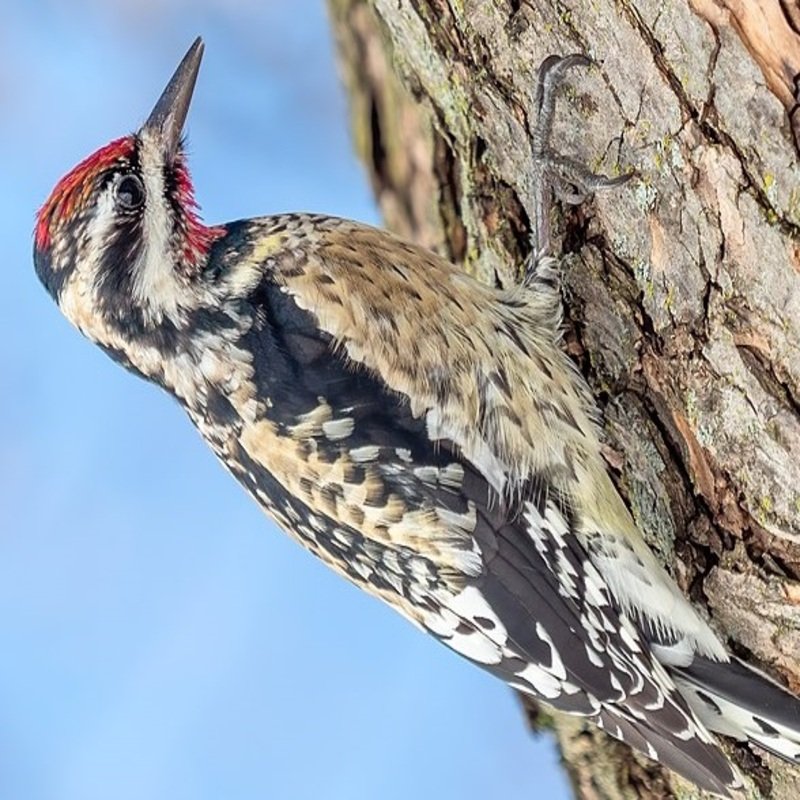In Canada and the northeastern United States, the yellow-bellied sapsucker is a medium-sized woodpecker. They belong to the genus Sphyrapicus in the family of Picidae.
The sap is collected in two ways by a yellow-bellied sapsucker. The round holes in the tree are not enlarged. The sapsucker probes for sap with its bill. Rectangular holes are shallower and must be kept open to flow sap. The sapsucker licks and swallows the sap from these holes. New holes are frequently constructed in a line with old holes, or above old ones.
Quick Overview: Sphyrapicus Varius – Yellow-Bellied Sapsucker
Body size: Around 8-9 in (20-23 cm) and a weight of 51 g (1.8 oz)
Main colors: Orange-red, White, Yellow, Brown
Range: Northeastern United States
Migratory Bird: Yes
Best time of the year to see in the U.S.: January, February, December
Conservation Status: Least Concern
Yellow-bellied sapsucker Description
An orange-red forecrown and a red throat distinguish the male. The female has a white chin, while the male has a red chin. The back is dark with a white rump and a huge white wing patch. Females have paler yellowish underparts. Until late winter, juvenile woodpeckers have brown plumage that resembles their sex.

Size
These birds have a length of 8-9 in (20-23 cm) and a weight of 51 g (1.8 oz). Their wings could range from 16-18 in (41-46 cm).
Feeding
Insects are the main diet. Bugs, ants, moths, and dragonflies are common. The sap is a good food source when insects are scarce. Sphyapicus various is a sap-loving tree. From October through February, berries and fruits are also eaten.
Habitat
This species inhabits northern deciduous and mixed conifer woods. They spend the winter in woodlands and semi-open areas.
Behavior
Sapsuckers have numerous displays for various interactions. They elevate their heads to show a potential mate their red or white throat patches. Aggressive crest and head shaking.
Sphyrapicus varius Scientific Classification
- Kingdom: Animalia
- Phylum: Chordata
- Subphylum: Chelicerata
- Class: Aves
- Order: Piciformes
- Family: Picidae
- Genus: Sphyrapicus
- Species: Sphyrapicus varius
Best time of the year to see
The best time to see these birds in the United States is during the winter season (December to February).
Distribution of the Yellow-bellied sapsucker in the USA
The yellow-bellied sapsucker can be found all over Canada, eastern Alaska, and the northeastern United States, as well as in the United Kingdom. The eastern United States, the West Indies, and Central America are all good places to spend the winter. In Ireland and the United Kingdom, this species has been discovered as an extremely rare vagrant.
The Yellow-bellied sapsucker can be found in the following states in the United States – Alabama, Arkansas, Connecticut, Delaware, Florida, Georgia, Hawaii, Idaho, Illinois, Indiana, Iowa, Kansas, Kentucky, Louisiana, Maine, Maryland, Massachusetts, Michigan, Minnesota, Mississippi, Missouri, Nebraska, New Hampshire, New Jersey, New York, North Carolina, North Dakota, Ohio, Oklahoma, Pennsylvania, Rhode Island, South Carolina, South Dakota, Tennessee, Texas, Vermont, Virginia, West Virginia, and Wisconsin.
